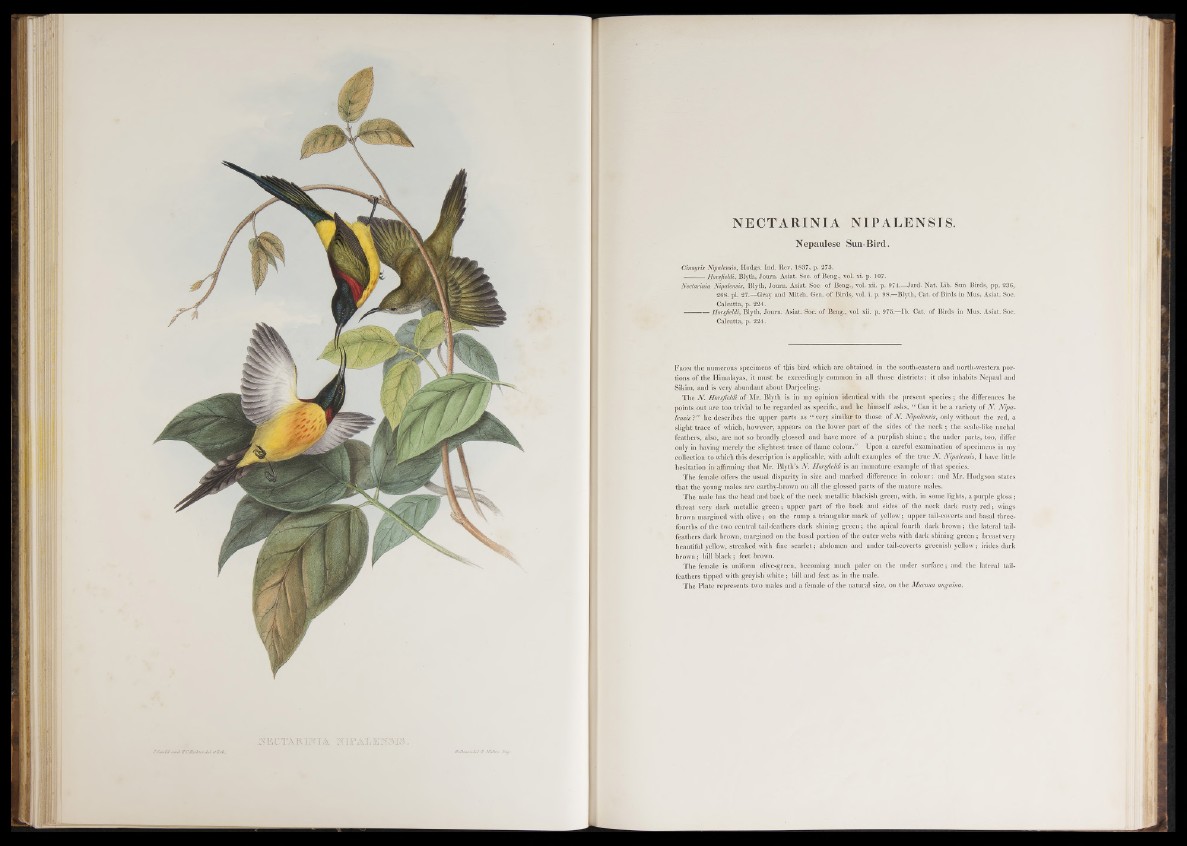
N E C T A R I N I A N I P A L E N S I S .
Nepaulese Sun-Bird.
Cinnyris Nipalensis, Hodgs. Ind. Rev. 1837, p. 273.
Horsfieldi, Blyth, Jonm. Asiat. Soc. of Beug., vol. xi. p. 107.
Nectarinia Nipalensis, Blyth, Journ. Asiat. Soc. of Beng., vol. xii. p. 974.—Jard. Nat. Lib. Sun Birds, pp. 236,
268. pl. 27.—Gray and Mitch. Gen. of Birds, vol. i. p. 98.—Blyth, Cat. of Birds in Mus. Asiat. Soc.
Calcutta, p. 224.
------------ Horsfieldi, Blyth, Journ. Asiat. Soc. of Beng., vol. xii. p. 975.—Ib. Cat. of Birds in Mus. Asiat. Soc.
Calcutta, p. 224.
F rom the numerous specimens o f this bird which are obtained in the south-eastern and north-western portions
of the Himalayas, it must be exceedingly common in all those districts: it also inhabits Nepaul and
Sikim, and is very abundant about Darjeeling.
The N . Horsfieldi of Mr. Blyth is in my opinion identical with the present species ; the differences he
points out are too trivial to be regarded as specific, and he himself asks, “ Can it be a variety of N . Nipalensis
? ” he describes the upper parts as “ very similar to those of N . Nipalensis, only without the red, a
slight trace o f which, however, appears on the lower part of the sides of the n e c k ; the scale-like nuchaf
feathers, also, are not so broadly glossed and have more of a purplish shine ; the under parts, too, differ
only in having merely the slightest trace of flame colour.” Upon a careful examination of specimens in my
collection to which this description is applicable, with adult examples o f the true N Nipalensis, I have little
hesitation in affirming that Mr. Blyth’s N . Horsfieldi is an immature example of that species.
The female offers the usual disparity in size and marked difference in co lo u r: and Mr. Hodgson states
that the young males are earthy-brown on all the glossed parts of the mature males.
The male has the head and back o f the neck metallic blackish green, with, in some lights, a purple g lo ss;
throat very dark metallic g ree n ; upper p a rt o f the back and sides of the neck dark rusty r e d ; wings
brown margined with olive; on the rump a triangular mark o f yellow; upper tail-coverts and basal three-
fourths of the two central tail-feathers dark shining g re e n ; the apical fourth dark brown ; the lateral tail-
feathers dark brown, margined on the basal portion o f the outer webs with dark shining green ; breast very
beautiful yellow, streaked with fine scarlet; abdomen and under tail-coverts greenish yellow; irides dark
brown; bill black; feet brown.
The female is uniform olive-green, becoming much paler on the under surface; and the lateral tail-
feathers tipped with greyish white ; bill and feet as in the male.
The Plate represents two males and a female o f the natural size, on the Mucuna anguina.